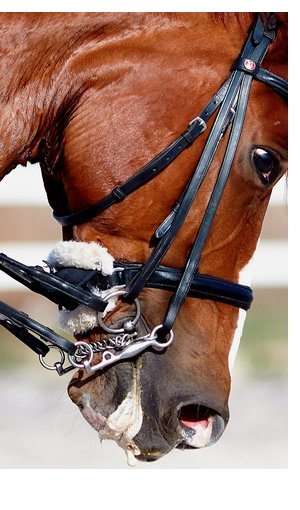 A horse’s mouth with a foreign object in it (a bit) will likely need some saliva to lubricate the fit and comfort of the bit. However, there is a belief that salivation aids relaxation. In other words, a happy mouth is a wet mouth. And a relaxed horse, has a happy mouth. In some show rings, you can observe horses in every stage of salivation from slight dribbling to huge globules of saliva trailing everywhere.
A horse’s mouth with a foreign object in it (a bit) will likely need some saliva to lubricate the fit and comfort of the bit. However, there is a belief that salivation aids relaxation. In other words, a happy mouth is a wet mouth. And a relaxed horse, has a happy mouth. In some show rings, you can observe horses in every stage of salivation from slight dribbling to huge globules of saliva trailing everywhere.
Exactly what triggers salivation? Some researchers contend that saliva is produced by salivary glands that are fooled by the bit into thinking that food has been ingested.
The horse begins to move his tongue back in preparation for swallowing. The back of the tongue is attached to the hyoid bone which is attached to his jaw bones and is the origination of the two most important neck muscles: one to the sternum and one to the inside shoulder. This relationship is the basis for the theory that a “stiff” tongue produces a “stiff” neck or vis-a-versa: a relaxed tongue encourages a relaxed horse. When the tongue moves back, the muscles relax.
Enter (ie: Dr Cook of Bitless Bridle fame). He disagree that salivating is a sign of relaxation.
While there may no problem with the above theory if the horse is not being asked to do more than walk around, salivate a little, swallow, and walk around some more, the question arises, “When he is physically exercising, how does he choose between breathing and swallowing?” Is he still able to do both adequately? How much stress is he under when the two activities conflict to the point that he is unable to do one or the other?
Because a horse breathes only through his nose, the tracheal passage remains open at all times unless the horse is swallowing. When the tongue moves back to swallow (or avoid the bit?), the root of the tongue partially (or completely) obstructs the airways by blocking the trachea and opening the oesophagus to allow food into the stomach.
Dr Cool feels that because a horse can either swallow or breathe (but not both at the same time), and because stimulating his salivary response happens in conjunction with drawing his tongue back in preparation for swallowing, the back-sitting tongue partially cuts off his airway. A horse who is salivating but cannot swallow adequately and breathe at the same time must necessarily drool or asphyxiate. Additionally a horse with even partially inhibited air cannot perform to his maximum capacity.
It’s possible that where you come down on this debate may be situational. A good rider who understands her individual horse might be able to judge the advantages of salivation in her own animal. How is his carriage? His neck muscles tight? His back stiff? His ears pinned?
By feeling the whole horse, one may find that a heavily salivating horse is relaxed in the poll, neck, shoulder and top line and thus be judged to be salivating positively and relaxed. In another horse, excessive salivation may be observed in conjunction with a tight poll, neck, and top line and be judged to be experiencing problems, not relaxation.
It is proven that some materials from which bits are fashioned encourage salivation. See Copper and Sweet Iron Bits.